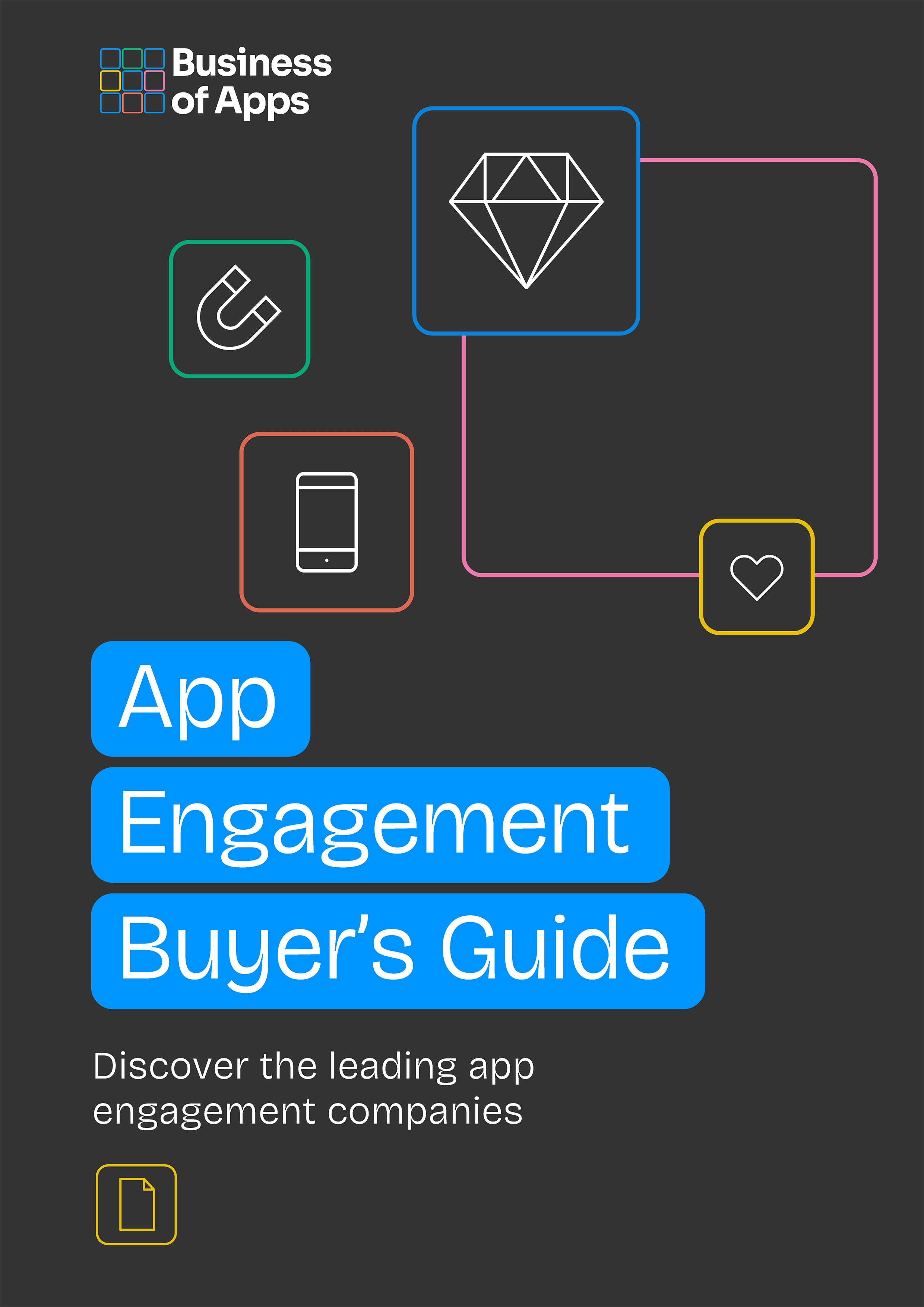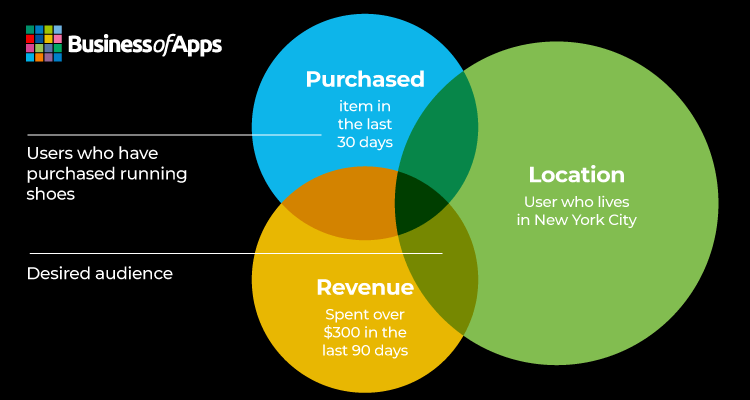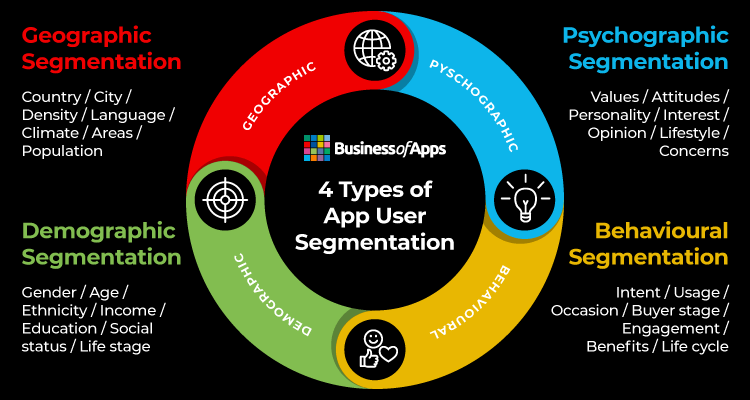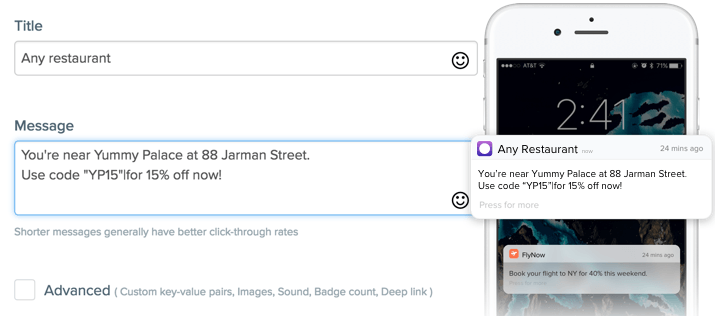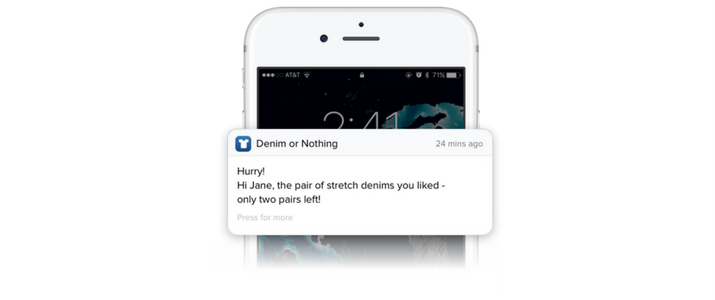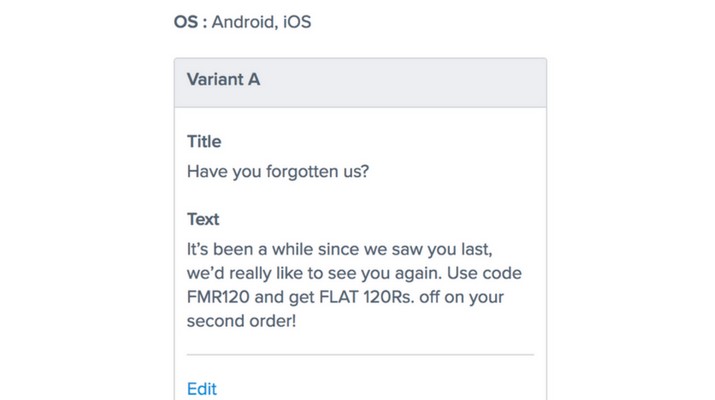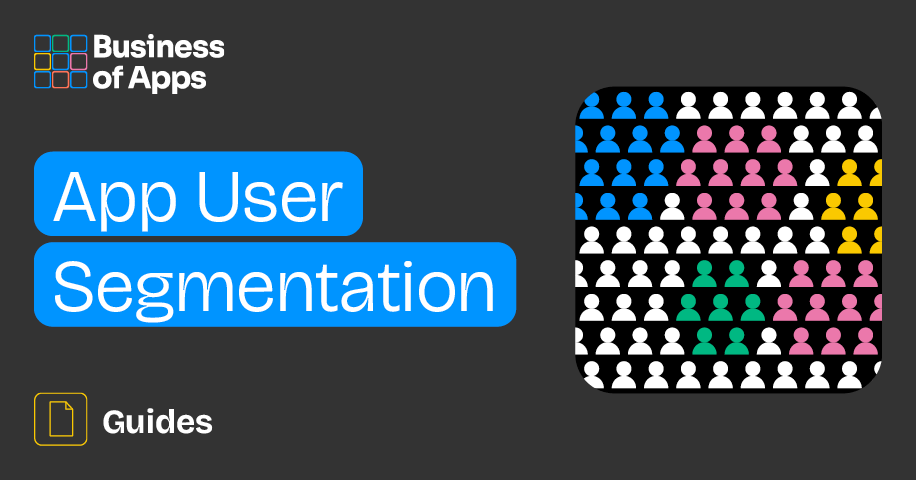
Have you ever been annoyed by an irrelevant push notification? Most mobile marketers are aware that irrelevant app notifications are among the primary reasons for app uninstalls, and yet the phenomenon persists. Why is that? One of the primary reasons is that they fail to segment their app users. So, let’s talk about app user segmentation, why it’s important, and how it can help supercharge your next mobile marketing campaign and guarantee you send no irrelevant messages ever again.
What is app user segmentation?
App user segmentation is the process of dividing your app users into distinct groups based on shared characteristics, traits, and behaviors. This allows you to create targeted marketing campaigns, personalize user experiences, and optimize your app’s functionality to better suit your users’ needs and wants.
App user segmentation
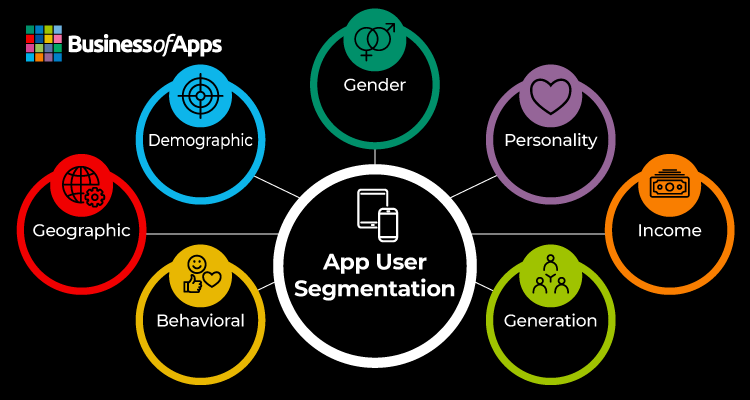
Why is user segmentation important?
User segmentation is important because it enables you to understand your app’s audience better. By breaking down your users into cohorts, you can identify their specific needs, preferences, and behaviors. This, in turn, allows you to create personalized experiences (e.g. personalized messaging across multiple channels) that meet those needs, which can lead to increased user engagement, retention, and revenue.
Performance marketers are shifting budgets to Browser Advertising 📈
Learn how brands like Walmart, Expedia and Nike drive incremental growth by reaching high-intent users before they hit search.
Get Your Free GuideBenefits of app user segmentation
- Cost efficiency – Increased conversion rates and reduced ad spending to reach target users
- Improved user profiles – App user segmentation helps you understand your users better, allowing you to efficiently give your users what they want and need by automating your multi-channel messaging efforts.
- Better user experiences – Bespoke mobile marketing campaigns increase conversions, improve retention, increase the lifetime value (LTV) of users, and boost user loyalty.
- Reactivating dormant users – App segmentation can help you identify dormant users, whom you can target with personalized messages to reactivate them.
- Proactive engagement to prevent churn – Proactive engagement based on app user segmentation helps reduce uninstalls and prevent the loss of revenue they cause.
Download our App Engagement Buyer’s Guide, covering all the trends, strategies, and metrics you need to know to ace app engagement in 2025.App Engagement Buyer's Guide
How does user segmentation work?
The first step to app user segmentation is to gather data on your audience. While it may seem obvious to segment users by demographic, it’s best to segment them based on multiple traits and characteristics. These include demographics, in-app behaviors, lifecycle stage, localization, or preferred device. This will help you understand how different segments interact with your app.
Once there’s enough data, marketers can use it to create more personalized, targeted campaigns.
App user segmentation at work
It’s worth noting though that app user segmentation is an always-ongoing process, so it’s also very important to keep testing and iterating until you’ve achieved the desired results. Additionally, remember that users are dynamic, so your segmentation should also be dynamic. You should keep an eye on any changes in habits, demographics, motivations, and trends to continuously refine your user segments and the campaigns based on those segments.
Common methods of app user segmentation
There are four main ways to segment your app audience – demographic, geographic, psychographic, and behavioral. To those, we’d add the less commonly used motivational and technographic segmentation for a total of six types of segmentation. Let’s quickly discuss each type in turn.
The four main ways to segment app users
Demographic segmentation
Demographic segmentation involves dividing users based on their age, gender, income, education, and other similar factors.
This type of segmentation is useful for understanding your app’s audience and tailoring your marketing efforts to reach specific demographics. For example, if you’re creating a fitness app targeted towards older adults, you might want to focus on messaging that emphasizes the importance of staying active as you age.
Geographic segmentation
Geographic segmentation involves dividing users based on their location. This can be helpful for targeting users with location- and time-specific promotions and content.
Example of a message segmented by location
Source: CleverTap
For example, let’s say you are running a coffee shop chain and have just built an app for your business. You will surely want to send your users messages with bespoke deals and discount codes to make sure they stay hooked in and guarantee their loyalty. And this is where app segmentation comes into place. To ensure you don’t annoy your users with irrelevant messages, you will need to segment them by geographic location. By doing this, you will then be able to target each cohort with discounts and deals redeemable in their area instead of sending all the discounts you offer to all your users.
For a time-based example, make sure you send users push notifications (and any other messaging for that matter) at a time when they are most likely to see and engage with them. A push sent at 3 in the morning is unlikely to see much engagement after all. But since not all of your users will be in the same time zone, you will need to segment them into time-based cohorts to ensure each group receives their messages at a time when are most predisposed to engage with them.
Psychographic segmentation
Psychographic segmentation categorizes users based on personal attitudes, values, interests, and/or personality traits.
Knowing who your users are and where they are based is often not enough. Knowing what they like and dislike, what they value in life, and what kind of person they are is thus quickly becoming a must as it allows for even greater degrees of personalization that tap into a person’s specific needs and wants when using an app.
Traits that influence consumption habits drawn from people’s lifestyles and preferences are also hugely important here, especially for retail apps.
Behavioral segmentation
Behavioral segmentation involves dividing users based on how and when they interact with your app. This type of segmentation is mainly based on actions or inactions, spending and usage habits, feature use, session frequency, and search history.
Example of an inaction-based app segmentation
Source: CleverTap
For a second example, let’s say you have a retail app. Below, you will find an example of how you can re-engage dormant users who haven’t made a purchase recently by sending them targeted messages with discount codes and prompting them to come back and make a second purchase.
Bahavioral app segmentation based on usage frequency
Source: CleverTap
Motivational segmentation
Motivational segmentation looks to give you a much greater idea about WHY people use your app. When approaching motivational segmentation, you are looking to find out what people are trying to achieve, aka what they are trying to gain when using your app. Certainly not easy questions to answer, but this approach to segmentation, when done correctly, can help you get a broad perspective on your user base, refine your target audience, and, in turn, develop a much more solid creative strategy.
Technographic segmentation
People use a variety of different devices to interact with brands these days, so it’s important to know your users’ technological preferences for the sake of better targeting. Technographic user segments are created based on people’s preferred technologies, software, and mobile devices.
Steps to app user segmentation
Collect user data
The first step to app user segmentation is collecting user data. As discussed above, this can include demographic information such as age, gender, and location, as well as app usage data such as frequency of use, time spent on the app, and features used. You can collect this data through in-app analytics tools, surveys, or by integrating with third-party data providers.
Here is some data that you might collect about your app users:
- Age: 18-24, 25-34, 35-44, 45-54, 55+
- Gender: Male, Female, Other
- Location: Country, City
- Frequency of use: Daily, Weekly, Monthly, Infrequent
- Time spent in-app: Less than 5 minutes, 5-10 minutes, 10-30 minutes, 30+ minutes
- Features used: Search, Messaging, Notifications, Purchases, etc.
Analyze the data
Once you’ve collected user data, you’ll need to analyze it to identify patterns and group users with similar characteristics and/or behaviors. This can be done manually or through the use of machine learning algorithms. By analyzing the data, you can identify commonalities between users and group them accordingly.
For example, you might find that users who are 18-24 years old and live in urban areas use your app daily, while users aged 45-54 and living in rural areas only use it once a twice a month. Based on this information, you might create a segment for “Urban millennials” and then tailor your app’s messaging features to better serve their needs and interests.
Define user segments
Once you’ve analyzed the data, you can define user segments based on shared characteristics. These segments should be distinct enough to warrant different marketing, user experience, and feature strategies.
Here are some examples of user segments:
- Urban millennials: Users who are 18-24 years old, live in urban areas, and use your app daily.
- Suburban families: Users who are 35-44 years old, live in suburban areas, and use the app weekly.
- Rural retirees: Users who are 55+ years old, live in rural areas, and use the app infrequently.
Tailor your app strategy to your user segments
Once you’ve defined your user segments, you can tailor your app strategy to better meet the needs of each segment. This might include creating targeted marketing campaigns, optimizing the user experience for each segment, and adding features that are specific to each segment’s needs.
Additionally, keep in mind that segmentation alone may not bring the best results. For a segmentation strategy to be successful, you need to craft messages that best speak to the needs and values of each cohort. Once you’ve segmented your audience, you need to find the language that each cohort is most likely to respond to and use it to develop an omnichannel messaging strategy that spans push, in-app, SMS, and email.
Test and optimize
Segmentation is an ongoing process because there might be flaws in your initial segmentation and also because users are dynamic. Always test to see if your segmentation actually works and continuously make optimizations by revisiting your approach and keeping an eye on any changes in habits, demographics, motivations, and trends.
User segmentation best practices
Knowing your users
Data is your best friend here. More data means a better understanding of your users and their habits and preferences, which, in turn, translates into more personalization for them and a better overall app experience.
Collecting data and getting feedback from your users is vital to mastering app user segmentation. You can only benefit from having as much useful information about your users as possible, but make sure you collect data in a way that follows privacy laws and regulations.
Once you have your data, we recommend creating imaginary profiles that best describe/represent each user cohort. You can then base your marketing efforts and messaging on those profiles to ensure the most optimal results.
Avoid over-segmenting your user base
It is often said that three major segmentation characteristics are more than enough. In fact, using more than three characteristics might be counterproductive.
We recommend applying the three-adjective rule. Communication expert Frank Luby says that “if you need more than three adjectives, or three dimensions, to define your initial segments, you may be overthinking and over-engineering the effort.” In other words, avoid over-segmentation.
User segments are designed to help you deliver bespoke experiences and messages to user groups, but they should also be general enough to allow for high degrees of automation too.
Set goals for each cohort
Once you have your user cohorts, it’s best to set actionable, measurable goals for each group. These goals should then serve as a reference point to help you keep track of your segmentation-empowered marketing efforts.
For example, let’s consider our “Urban Millennials” cohort again. Once you know who belongs in that category and have crafted a marketing strategy and messaging that speaks to them and their needs, it’s a good idea to set a goal (e.g. number of in-app purchases) that you’d be looking to achieve as a direct result of your segmentation-based marketing campaigns. The goal will naturally vary depending on your app and offering, but the idea is the same.
Setting goals will help you streamline and optimize your efforts.
Test and optimize
We’ve mentioned this before but can’t stress this enough, continuous testing and optimization is the name of the game when it comes to segmentation and you should always be looking to improve your segments with new data as your user base changes with time. And as your cohorts change, so should your marketing and messaging efforts too.
Conclusion
App user segmentation is a powerful tool that can help you better understand and meet the needs of your app users. By collecting and analyzing user data, defining user segments, and tailoring your app strategy and messaging to each segment, you can increase user satisfaction, engagement, and retention.


